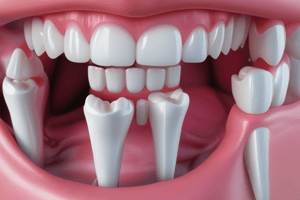Podcast
Questions and Answers
What is a potential result of applying a featheredge margin?
What is a potential result of applying a featheredge margin?
- Increased strength of the restoration
- Over contoured restorations (correct)
- Adequate bulk at the margin
- Reduced conservation of tooth structure
A chamfer margin is particularly suitable for all-ceramic crowns.
A chamfer margin is particularly suitable for all-ceramic crowns.
False (B)
What is the angle that a shoulder margin should form with unprepared tooth structure?
What is the angle that a shoulder margin should form with unprepared tooth structure?
90 degrees
An excessively tapered preparation can lead to a __________ margin.
An excessively tapered preparation can lead to a __________ margin.
Match the margin type with its suitability:
Match the margin type with its suitability:
What should the angle of the diamond be held at while preparing the gingival margin?
What should the angle of the diamond be held at while preparing the gingival margin?
Over reduction of the tooth structure can enhance retention.
Over reduction of the tooth structure can enhance retention.
What is the primary objective of beveling a margin?
What is the primary objective of beveling a margin?
What is the recommended method to prevent heat buildup when preparing retentive features?
What is the recommended method to prevent heat buildup when preparing retentive features?
Chemical agents used for cleaning tooth preparation are safe and do not irritate the pulp.
Chemical agents used for cleaning tooth preparation are safe and do not irritate the pulp.
What is one of the basic tenets of restorative dentistry regarding tooth structure?
What is one of the basic tenets of restorative dentistry regarding tooth structure?
The thickness of the remaining dentin is inversely proportional to the ________ response.
The thickness of the remaining dentin is inversely proportional to the ________ response.
Match the following guidelines for conservation of tooth structure with their descriptions:
Match the following guidelines for conservation of tooth structure with their descriptions:
What can contribute to pulpal damage during restorative procedures?
What can contribute to pulpal damage during restorative procedures?
Microleakage can lead to bacterial action contributing to pulpal damage.
Microleakage can lead to bacterial action contributing to pulpal damage.
What should be done to ensure adequate tooth structure for fixed prosthesis placement?
What should be done to ensure adequate tooth structure for fixed prosthesis placement?
What is a consequence of excessive taper in tooth preparation?
What is a consequence of excessive taper in tooth preparation?
Traditionally, subgingival margins are considered better for dental restorations than supragingival margins.
Traditionally, subgingival margins are considered better for dental restorations than supragingival margins.
What is the primary reason for axial reduction in tooth preparation?
What is the primary reason for axial reduction in tooth preparation?
The practice of routinely placing margins subgingivally has been linked to ______.
The practice of routinely placing margins subgingivally has been linked to ______.
Match the margin placement types with their advantages:
Match the margin placement types with their advantages:
Which of the following is NOT a disadvantage of subgingival restoration margins?
Which of the following is NOT a disadvantage of subgingival restoration margins?
The placement of the finish line has no impact on the structure of the final restoration.
The placement of the finish line has no impact on the structure of the final restoration.
What kind of margins should be used whenever possible in dental restorations?
What kind of margins should be used whenever possible in dental restorations?
Flashcards are hidden until you start studying
Study Notes
Bio-Mechanical Principles
- Improper tooth preparation can negatively impact long term dental health.
- Axial reduction is necessary for sufficient restorative material thickness and to avoid over contouring.
- Margin placement is vital for restoration fabrication and ease of cleaning.
- Margins should be as smooth as possible and fully exposed for cleaning.
- Margins should be placed where they can be finished by the dentist and kept clean by the patient.
- Margins should be placed where they can be duplicated by the impression without tearing or deforming the impression.
- Supragingival margins are preferred over subgingival margins as they are easier to prepare, finish, and keep clean.
Margin Types
- Featheredge margins are not recommended due to a lack of bulk at the margin and potential for over contouring.
- Chisel-edge margins are associated with excessively tapered preparations or incorrect axial reduction.
- Chamfer margins are ideal for cast metal crowns and metal portions of metal-ceramic crowns as they provide good bulk and are easily identified.
- Beveled margins are suitable for cast restorations when a ledge or shoulder already exists. They allow for bending or burnishing of the cast metal margin and minimize marginal discrepancies, protecting unprepared tooth structure.
- Shoulder margins are preferred for all-ceramic crowns and facial parts of metal-ceramic crowns.
Considerations For Tooth Preparation
- Avoid excessive pressure, high rotational speeds, and inappropriate bur types and shapes during preparation to minimize heat generation.
- Use water spray strategically to cool the cutting area, especially when preparing grooves or pinholes.
- Chemical agents used for cleaning and degreasing should be avoided as they can irritate the pulp.
- Remove all carious dentin to prevent bacterial action leading to pulpal damage under restorations.
- Minimize pulpal effects by preserving as much tooth structure as possible.
- The thickness of remaining dentin is inversely proportional to the pulpal response.
Guidelines For Conserving Tooth Structure
- Use partial coverage restorations over full coverage restorations.
- Prepare teeth with minimal convergence angle (taper) between the axial walls.
- Reduce the occlusal surface evenly and anatomically for uniform restoration thickness.
- Ensure even and adequate reduction of the axial tooth surfaces for proper axial contour.
- Choose a conservative margin compatible with other tooth preparation principles.
- Avoid unnecessary apical extension of the preparation.
Studying That Suits You
Use AI to generate personalized quizzes and flashcards to suit your learning preferences.




